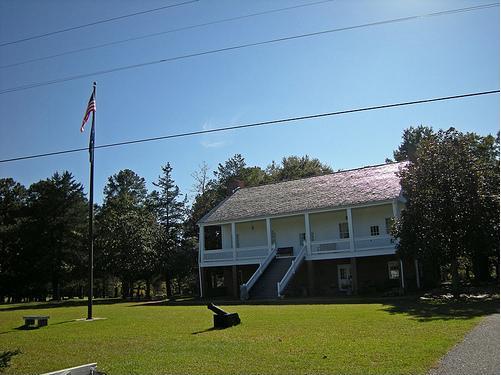By Rolonda Teal
.JPG) Ft. Jesup was the largest fort west of the Mississippi River by 1845 and had a garrison of 1/3 of the entire U.S. Army - about 1,090 soldiers. It was built on 16,902 acres and controlled all the land three miles from the flag staff. The flagstaff was roughly where the modern flag staff is now. It had 88 military buildings, several support buildings, as well as private residences for officers and civilians who lived and worked in the area.
Ft. Jesup was the largest fort west of the Mississippi River by 1845 and had a garrison of 1/3 of the entire U.S. Army - about 1,090 soldiers. It was built on 16,902 acres and controlled all the land three miles from the flag staff. The flagstaff was roughly where the modern flag staff is now. It had 88 military buildings, several support buildings, as well as private residences for officers and civilians who lived and worked in the area.

It was built historically to be on the highest ground between the Sabine River and Natchitoches and was just a day's march to both locations. The Spanish already had one route, El Camino Real de la Tejas which ran north of Ft. Jesup in a more direct line from Los Adaes. As Americans came into the region and in order to avoid some of those predominately Spanish areas, they created the Ft. Jesup Road which ran along current-day Highway 6. Depending on who you were, what the weather was, and who was chasing you determined which road you took.
There was a very sparse settlement near Ft. Jesup and this region had at one time been a "No-Man Land" between the Mexicans and the Americans and before that the Spanish and the Americans for over 20 years. With no official government in place, there were tons of outlaws in the area. That was one of the jobs of Ft. Jesup soldiers-to come in and sweep those outlaw areas. Even before the fort was built, Ft. Claiborne soldiers often made sweeps and burned any structures they found that didn't have a Spanish land grant attached to it.
Several of the Americans that were in Natchitoches in the 1820s and 1830s often went to Ft. Jesup and to Shawnee Town for different recreations like balls and dances. Natchitoches society was still very Catholic and French. For many American Protestants, Ft. Jesup was the closest place they could go for high-society entertainment. It was also there that they could meet non-Catholic girls to date and marry. There was even one ball held in the early 1830s in honor of three Mexican officers who were visiting the fort. The military band sometimes performed at these social events. Supposedly, there was a hotel opened at Ft. Jesup in the 1830s that was located slightly outside the military garrison. This structure suggests there was enough traffic near the fort to warrant its construction.Shawnee Town differed from the fort in obvious way but also in more subtle ones as well. For example it supposedly formed in 1831 when the sale of alcohol was outlawed within three miles of the flag staff. Soldiers, visitors, and local residents were forced to go elsewhere for liquor and the town formed in response to a need. It has been suggested that the name itself is a corrupted form of the word "Shiney" which was a term for liquor.
Only about 10-15% of the documents created regarding Ft. Jesup's history have been studied, leaving one to believe that other information regarding Shawnee Town such as its exact location may be eventually be revealed. However, what is known is that there is currently a Shawnee Town Road that runs supposedly where the town was located. A local doctor who lives in that area said that he's found artifacts (coins, liquor bottles, nails) in his yard from that time period while planting flowers. Several of his neighbors have also found artifacts that support some habitation of the area. Basically the character of the town would have been one where the soldiers and travelers went to get illicit recreation. Local folklore says it was the town that people frequented when they wanted to do things that were illegal, immoral or both.